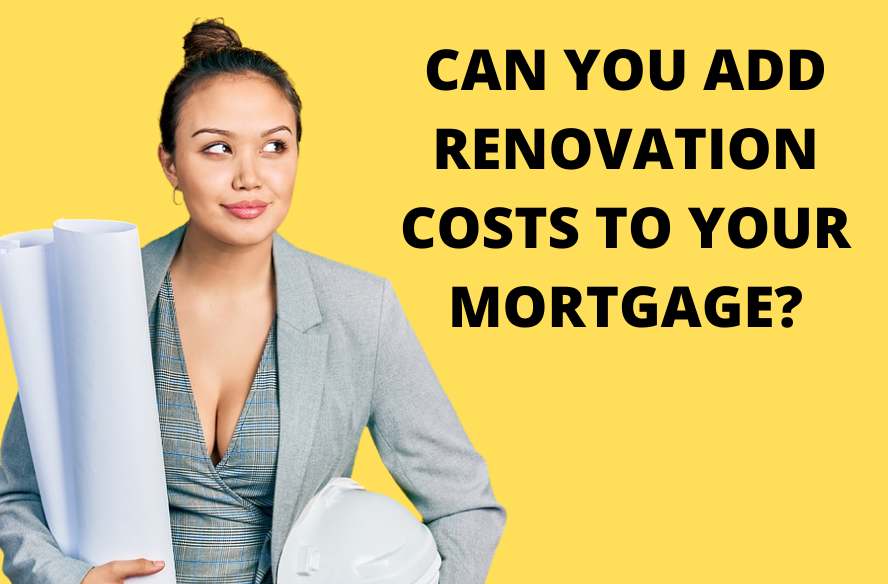Finding the ideal home can be challenging, if not impossible, especially in a hot real estate market. You might find a home where you love the layout, but the kitchen and bathrooms haven’t been updated for fifty years. Sure, that psychedelic wallpaper, and vintage cabinetry might have been quite the rage in the 70’s, but doesn’t quite cut it in modern times. All it needs is a few renovations, and your perfect home will then be complete.
The only problem is how you’re going to pay for it. Once you factor in your deposit, down payment, and closing costs, you may not have anything left for renovations. Fortunately, there is a solution.
Purchase Plus Improvements Mortgage
Most lenders offer a Purchase Plus Improvements product, which will allow you to add the cost of your renovations to your mortgage, therefore financing the entire shebang. The maximum amount of the improvements that can be added is $40,000, however it may be possible to get a higher amount in some situations.
For the most part, it works just like any other mortgage arrangement. The only difference is you would need to obtain a detailed quote from a contractor after your offer to purchase has been accepted. This quote would then be sent through to the lender for approval. You don’t need to worry about shopping around with different contractors at this stage, as you’re not obligated to use the contractor providing the quote. All you need is a single quote for now.
Once the lender has accepted the quote from your contractor, we would then need to order an appraisal which will confirm both the purchase price, as well as the as improved value.
At time of closing, the mortgage lender will send your lawyer the funds to complete the purchase of the home, along with the funds for the renovation. The lender will instruct your lawyer to hold back the additional funds which would be held in trust until the renovations have been completed.
You would then notify us that the work has been done. The appraiser would then come out to your home a second time only to confirm the work has been completed. They are not required to reassess the value, as that would have been done with the initial appraisal.
Once the lender has received the confirmation, they would then instruct the lawyer to release the funds to you. No portion of the additional funds would be released to you until the renovations have been 100% completed.
Can All Types Of Renovations Be Included?
It’s important that the renovations increase the value home by a similar amount. For example, if you are purchasing a home for $900,000, and the renovation quote is for $40,000, then the renovations would need to increase the value of the home to $940,000. As some renovations may only add minimal value, if any, not all types of renovations would be accepted.
Here are some examples of common renovations that add the most value, and are therefore perfect candidates for the program:
- Kitchen
- Bathroom
- Roof replacement
- Painting
- Flooring
- Windows and doors
- Basement finishing
The above renovations would all add significant value to the home, and are therefore accepted. Now let’s take a look at the other side. Here are some examples of renovations that wouldn’t be acceptable under the program:
- Adding a pool in the backyard
- Appliances
- Lighting
- Dated renos (such as glass blocks)
- Removing a wall
- Adding a wine cellar
- Unusual or unique renovations (adding a bar in the middle of the living room for example)
Sure, some of the above can all make a big difference in the overall enjoyment or attractiveness of your home, however they wouldn’t qualify for the purchase plus improvements program as they add minimal value, if any at all.
Down Payment Requirements
The down payment requirements do not change with a purchase plus improvements mortgage. The only exception is that it will be based on the new ‘as improved’ value, not the purchase price. For example, if you were purchasing a $900,000 home with 20% down, and your improvements were $40,000, then the 20% would be calculated based on the $940,000, not the $900,000. In other words, your 20% down payment would increase from $180,000 to $188,000.
What if you have less than 20% down payment?
You can still be eligible for a purchase plus improvements mortgage with as little as 5% down. Regardless of whether you’re looking for a purchase plus improvements mortgage or not, a 5% down payment will only allow you to buy up to a maximum purchase price of $500,000. If you’re purchasing for more than $500,000, which is pretty much everything these days, then you’ll need 10% on any amount over $500,000 and up to $999,999. For example, if you were purchasing a home for $800,000, then the minimum down payment would be $25,000 on the first $500,000 (5%), and then $30,000 for the remaining $300,000 (10%) for a total minimum down payment of $55,000. Remember, if you’re proceeding with a purchase plus improvements mortgage, then your minimum down payment is calculated on the as improved value, not the purchase price.
If you are purchasing for over $1,000,000 (or if the ‘as improved’ value is over $1,000,000), then the minimum down payment will be 20%.
How Long Do You Have To Complete The Renovations?
This would be lender specific. Some will give you a 90 day window, while others will allow you up to one year. If you think you’ll need a bit longer, then it’s best to let us know at the time so we can find lender best suited to your needs.
Drawbacks To A Purchase Plus Improvements Mortgage
The biggest disadvantage is that you’ll need to fund the initial reno yourself. You will not be reimbursed until the renovations have been completed and the lender has authorized your lawyer to release the funds to you.
This means that you’ll need to find a way to cover the initial cost on your own.
If you don’t have any additional cash available, then you might want to consider a personal line of credit, or credit card. Keep in mind that most credit cards carry a pretty high interest rate, so you’ll want to try to cover as much as you can from your own savings if possible. It’s important that you DO NOT charge anything to your credit card or line of credit before closing on your new mortgage without consulting us first.
You can also try to work something out with your contractor where they don’t receive their final payment until after the work has been completed. This might not be for a few weeks after completion as the appraiser still needs to come out to inspect the property and prepare the report. The lender may then need a few days to review, before giving the final instruction to your lawyer to release the funds.
Another drawback is that you’ll be paying interest on the money held in trust by your lawyer, even though it has not been released to you. As the lender has already dispersed the entire amount, interest is still payable from day one, regardless of whether or not you have received the funds.
Reducing Your Down Payment To Pay For Renovations
For those with larger down payments, the easiest thing to do is to simply reduce your down payment and then use the difference to complete your reno. For example, if you were purchasing a home for $1.4 million with a $500,000 down, you could reduce your down payment to $400,000, therefore freeing up $100,000 to fund your reno. You can always use your prepayment privileges to apply anything left over back into your mortgage, if applicable.
Keep in mind that renovations always tend to run over budget, so it’s always best to hold back a little more than what you think you’ll need.
This can also work if you have less than 20% down payment. Say you’re purchasing a home for $975,000 with a $120,000 down payment. You can reduce your down payment to as low as $72,500 and then use the leftover funds to pay for your renovation. Note that lowering your down payment may result in a higher CMHC insurance premium, which we would discuss with you in detail when determining your options.
Are You Looking To Renovate Your Current Home?
If you already own a home and you think it could be spruced up a bit, then a similar product is available, which is called refinance plus improvements. This is a product that is seldom used as most people have enough equity to allow them to refinance their homes to access the required funds. No special program needed. The refinance plus improvements would only be used if there was not sufficient equity in the home, as you’re only able to access 80% of your home’s appraised value.
Another option would be to add a Home Equity Line of Credit (HELOC) to your mortgage, which can be done without having to refinance. The better option would depend on a variety of different things, such as your cost to break your current mortgage, how much money you need to borrow, and how soon you need the funds. Every situation can be a bit different, so we would be happy to discuss your options with you to determine which option would be best for your needs.







